Water Ranching in Mexico
Air Date: Week of August 21, 2020
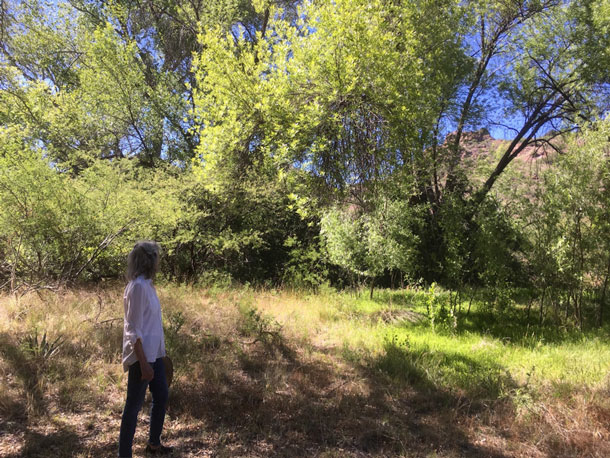
Valer Clark next to a riparian forest, which serves as a bridge between the water and the land (Photo: Bobby Bascomb)
Bobby Bascomb visits acclaimed land preservationist Valer Clark at her ranch, Cahone Bonito, in Agua Prieta, Mexico. Valer has been a steward of dried up lands in Mexico and the southwestern US since she purchased this property in the 1970’s, and she’s dedicated herself to finding ways to restore and maintain it. Alongside Valer and other experts, Bobby explores this ecosystem, its history, and the simple techniques used to bring it back to life.
Transcript
BASCOMB: It’s Living on Earth, I’m Bobby Bascomb.
Today the lands of the Southwestern US and Northern Mexico are considered desert or semi-arid. But for a couple months each year the region is awash with water from the seasonal monsoons. The normally dry river beds fill with flood water and swell to create habitat for all manner of water birds and amphibians. The watery paradise is short lived though, and most of those streams dry up in a matter of weeks. But that wasn’t always the case. A network of streams, rivers and wetlands once crisscrossed the landscape. In fact, more than 150 years ago, around the time of the Civil War, people in the region struggled with malaria, a mosquito-born illness typically associated with tropical wet climates. Last year, I went to Mexico and I found a ranch owner that’s working on ways to keep some of that water on the land longer.
[FOOTSTEPS AND VOICES IN ECHOEY HALL]
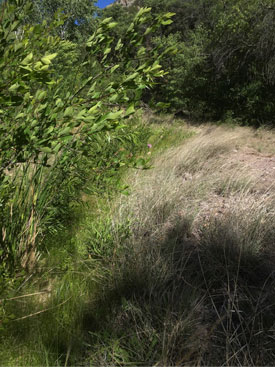
Dry grass vs. healthy green grass. (Photo: Bobby Bascomb)
My journey starts at the Gadsden Hotel in Douglas, Arizona. It’s a grand building with walls the color of gold and marble pillars holding up an ornately painted ceiling. A step in the gray marble staircase bears a chip legend says was left by the Mexican Revolutionary Pancho Villa when he rode his horse up these stairs. Today it’s a popular spot for weddings and it’s here that I met Valer Clark.
CLARK: Good morning, so, this is a piece of history.
BASCOMB: The opulence of the hotel hints at an earlier time of prosperity and wealth. Valer says the whole region, north and south of the border, was made rich more than 100 years ago by the same things.
CLARK: This was copper, cotton, and cattle. The three Cs, you know, all in the early 1900s.
BASCOMB: Those three Cs made a lot of money but heavily degraded the land. Before the arrival of settlers the region didn’t have much water but there were some dense grasslands. Forests grew alongside rivers that meandered across the open landscape. And wetlands popped up every 20 or 30 miles along those rivers. But when Valer first visited back in the 70s, decades of mining and agriculture left the arid soil dry and cracked, few trees remained and the river beds were deeply eroded.
Valer came from a wealthy family in New York City. She and her husband at the time were travelling in Mexico and fell in love with the austere land. The wildness of the open parched landscape drew them in.
CLARK: We just came across this ranch, by accident. And he said, Well, why don't we bid on it, and I bid so low, I didn't think we'd ever get it. So I was thinking in terms of this being a summer place or something like that.
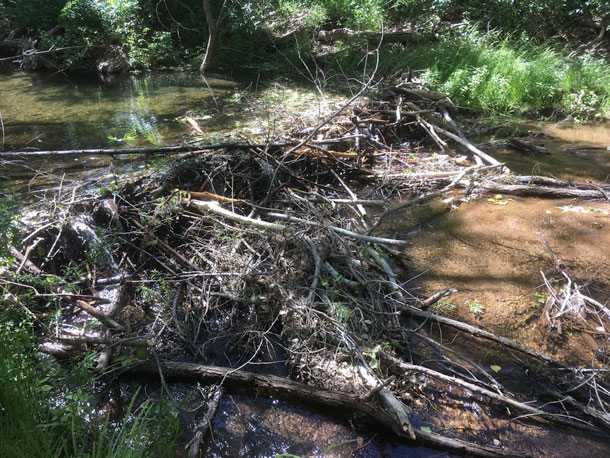
A beaver dam. (Photo: Bobby Bascomb)
BASCOMB: That whim of a purchase of a summer place eventually ballooned into her life’s work.
CLARK: When I got here and started seeing the lack of water and seeing the situation, what it looked like, and the hills were bare, and there was no grass. And I thought I wonder if you could make a change. I wonder if there's something you can do about this. And I started doing it. And I realized you can, and I guess I got hooked.
BASCOMB: Valer eventually bought and rehabilitated some 150,000 acres of land in northern Mexico and the Southwest US. That’s more than 10 times the size of Manhattan. And her work here has been transformative, says Ron Pulliam.
PULLIUM: There are four great geological forces: there's volcanism, plate tectonics, there's erosion. And there's Valer. And Valer is one of the forces that has created the landscape around us here.
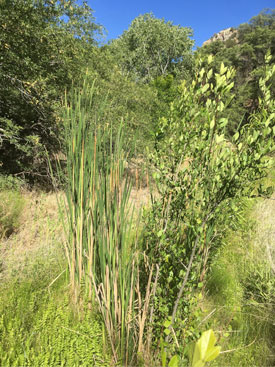
Wetland greenery. (Photo: Bobby Bascomb)
BASCOMB: Ron is an ecologist, formerly with the US Department of Interior, and founder of the nonprofit Borderlands Restoration Network.
[CAR DOOR SOUNDS, DRIVING SOUNDS]
BASCOMB: I pile into a pickup truck with Ron. Valer, in her own truck, leads the way out of Douglas, Arizona and across the border to Agua Prieta, Mexico.
[DRIVING SOUNDS]
BASCOMB: We leave behind the maquiladora factories in the duty-free trade zone of Agua Prieta and drive an hour southeast to Valer’s ranch. Pavement and two-story buildings give way to dusty soil and brittle pale green grass. To me, as a New Englander, the landscape looks rather inhospitable, but Ron says this is prime cattle grazing territory.
PULLIAM: Generally speaking now, the stocking ratios are on the order of one cow to one hundred or two hundred acres in this area. And then think of around the turn of the century, 100 times that number of cows.
BASCOMB: And all those cows led to disaster for this delicate landscape.
PULLIAM: And so if you put hundreds of cows out on a small area here you basically reduce all the ground cover. So, when the rain comes it just runs off the land rather than being caught up in the vegetation.
BASCOMB: And keeping that rainwater on the land is the fundamental key to what Valer is doing to rehabilitate her property. More water will mean more grass and trees, habitat for the wildlife that was once common here. It’s sort of a build it and they will come philosophy.
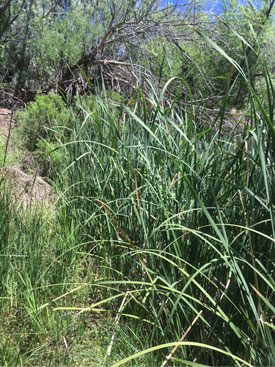
Abundant reeds in the wetlands. (Photo: Bobby Bascomb)
[FOOTSTEPS ON GRAVEL]
BASCOMB: We arrive at Valer’s Cajon Bonito Ranch and she takes me on a walk around her property. She wears a cowboy hat over thick gray hair, jeans, and a white button-down shirt. She is tiny, so petite one might think her fragile, but she is shockingly strong and sets a fast pace over the rugged terrain.
In a similar way, Valer’s solution to rehabilitating the degraded land is equally small but powerful.
CLARK: This is what we call a gabion, which is a wire basket that is filled with rocks.
BASCOMB: That’s it, a wire basket full of rocks. They’re about 3 feet tall, some just 5 or 6 feet wide, others more than a hundred feet across. Valer and her crew have built more than 20,000 of them on her property. They all sit in riverbeds which are dry most of the year until the monsoon rains come. That’s when the gabions get to work. They slow down the water rushing through the river bed so silt can accumulate behind them, like a sponge.
CLARK: And that sponge holds the water. And so the water, instead of just whipping through fast, when it rains, 30% of it’s held back and goes into the ground. And so it filters down very slowly. And this is somewhere near the bottom. So you see pools of water.
[WATER SOUNDS]
BASCOMB: Those pools of water are home to insects, birds, rare frogs, and endangered fish species.
CLARK: And trees, all these trees coming up, they’re a result of having water here.
BASCOMB: So how old are these trees? I mean, these are 30, 40 feet high. So how old are they?
CLARK: Not old at all, these grow very fast, these grow very fast, these trees. Some of them grow 10 feet a year.
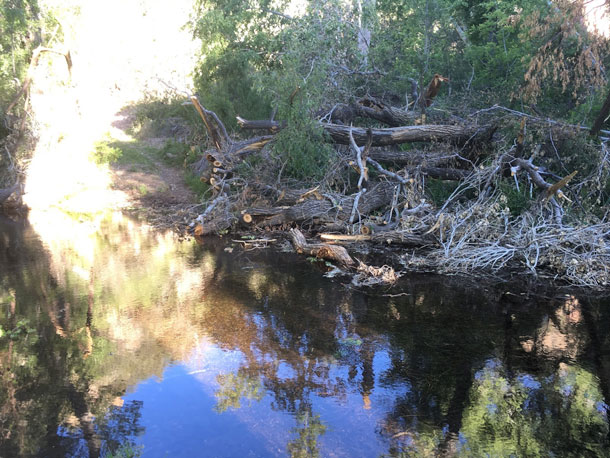
During monsoon season, rivers in the area fill briefly and bring green before quickly drying back out. (Photo: Bobby Bascomb)
BASCOMB: Nearly all these trees have sprouted up since Valer began keeping more water on the land. Near the stream, a canopy of cottonwood trees towers over us and a lush green understory creates the feeling of a jungle that follows the narrow band of water. We continue our walk on the edge of the forest, which she says is a vital corridor for wildlife in the region.
CLARK: We’ve seen ocelot, we've seen bobcats and lions and bears and coatimundis and javelinas, ring tailed cats. . . .
BASCOMB: Have you seen a jaguar?
CLARK: We didn’t but a jaguar was photographed right coming….
BASCOMB: [screams] my goodness! What is that?
CLARK: That is a gila monster!
BASCOMB: You’re kidding.
CLARK: They’re very rare, I mean they’re very very… yes.
BASCOMB: I almost stepped on it.
CLARK: Take a picture, take a picture! Quickly. That’s a find. You found, that was very exciting.
BASCOMB: After being startled by the venomous lizard Valer and I head back to her ranch house. We meet up with Ron Pullium to see some more of Valer’s work.
[DRIVING SOUND]
BASCOMB: We drive past parched bare earth cracked into the shape of a hexagon and stop at a different ecosystem all together.
[WETLANDS SOUNDS, RUNNING WATER, BIRDS]
BASCOMB: Instead of a riparian forest this is a wetland teeming with life. Reeds and cat tails poke up through the water. At least a dozen different species of brightly colored birds dart about, butterflies sun themselves, and bright blue dragon flies copulate in mid-air. Ron Pullium says this region is a hotbed for insect diversity, including some 450 different species of bees and….
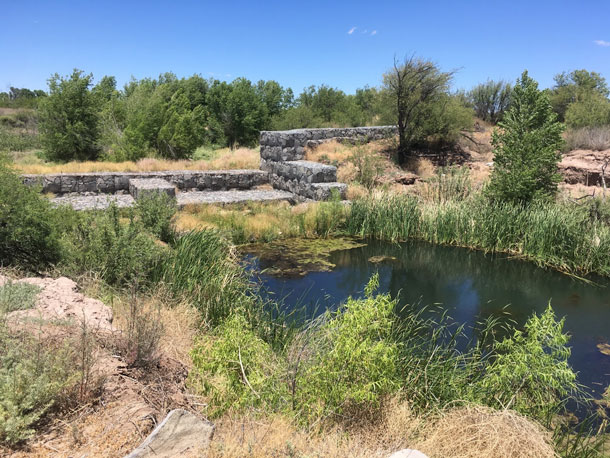
Gabions are baskets of rocks that Valer Clark places in stream beds to slow the water as it rushes through. (Photo: Bobby Bascomb)
PULLIUM: Very strangely, the desert area through here has exceptionally high dragon fly diversity. And that's one of the signs of the past extent of wetlands in this area.
BASCOMB: Indeed, historical records from the Spanish settlers suggest this region was once a patchwork of wetlands just like this. Gary Paul Nabhan is a desert ecologist with the University of Arizona. He says the word Sonora, as in, the desert here, actually means spring-fed wetland in a native language.
NABHAN: In an area the size of Connecticut, you might have 20, maybe 30 of these, but they were so important to human life and to wildlife that every one of them was named. And probably one in 10 is left, probably more like one in 20 or one in 30.
BASCOMB: How important are these types of habitat for the whole region, for the ecosystems?
NABHAN: Well, incredibly so, -- and look at the Vermilion flycatcher, I'm sorry, they’re showstoppers. They are just so beautiful.
BASCOMB: Oh, they're bright red, and they're beautiful. Yeah, yeah.
NABHAN: First of all, in a historical ecological sense. These were the seed beds for all the, the vegetation. But secondly, they were the hubs of human habitation because this is where all the ecosystem services happen. And so they were as important as the oases were in the Sahara Desert, you would travel 30 miles out of your way to reach a place like this.
BASCOMB: And important for migrating wildlife too. These were wet stepping stones between central Mexico and Canada.
[WETLAND SOUND]
BASCOMB: Bright and early the next morning I meet up with Ron Pullium to go birding near another wildlife corridor, which it turns out was a highway of a different sort not so long ago.
BASCOMB: Morning!
PULLIUM: We’re up for a late morning walk.
BASCOMB: Late morning? It’s 5:30.
PULLIUM: [LAUGHS]
[WALKING SOUNDS]
BASCOMB: We walk alongside a small creek, craning our necks up, hoping to spot some birds.
PULLIUM: This creek is interesting just in itself it was protected by Valer because it was identified as the most intact fish stream in northern Mexico, and perhaps the most intact in all of Mexico. And it had several species, five or six species, of rare and endangered species. And this also used to be the bus route. And it looks like a pristine natural stream now. But in the 1950s there was a biologist that camped on the shore right over here. And he, in the night, he counted five buses driving up the stream. This was the road between Sonora and Chihuahua.
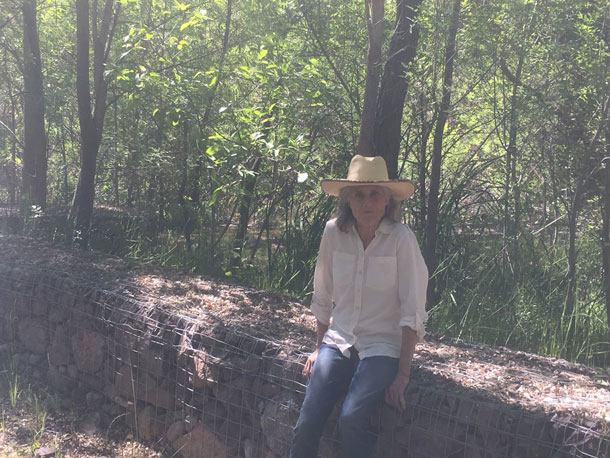
Valer Clark perches on a gabion. (Photo: Bobby Bascomb)
BASCOMB: Somehow those endangered fish species managed to survive living in a bus route and are now on the rebound. Even beavers have re-colonized the river. At one-point Valer Clark introduced a few beaver pairs to one stream on this river. But now several more have been drawn to the water that is once again running free and the broad tailed volunteers are getting to the business of building dams for her.
For all her ecological work, Valer is still mindful of serving as a model for other ranches in the region that depend on raising cattle for their livelihood. She removed most of the cows from her ranch when she bought the place. But she did keep a small herd and is very deliberate about where and when they graze. And it’s paid off. Her ranch manager recruited members of his family to enter three novio steers in a large cattle exposition.
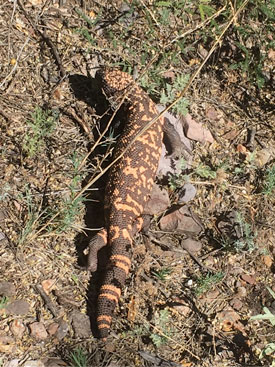
Bobby narrowly avoided stepping on this gila monster while out with Valer (Photo: Bobby Bascomb)
CLARK: All the people in Sonora bring their animals to this big thing, this big do. And so his daughter, Sarah, won first prize among novios. And she won the grand champion, the overall prize. And then when the animal was slaughtered, we won overall, the prize of having the best cut up meat too. So we couldn't, we couldn't get any better than that.
BASCOMB: The hope is that public win will encourage other ranchers in the area to explore the sustainable ranching that results in award-winning beef. And Valer’s biggest hope is that they will see the advantage of rehabilitating their own degraded land.
CLARK: I think the next thing is having people come and see the benefits of what we've done, that it is possible to turn land around, I think it's important, the next step would really be to reach out to other people, and let them know that it's possible to heal really sick land.
BASCOMB: In fact, Valer’s work is already spreading across the region, literally. The water she retains with her gabions does not stay on her land alone. It seeps into the water table and flows downstream, hydrating degraded lands for miles around. And in a region where water is wealth, Valer is already sharing in the profits of restoration.
Links
Living on Earth wants to hear from you!
Living on Earth
62 Calef Highway, Suite 212
Lee, NH 03861
Telephone: 617-287-4121
E-mail: comments@loe.org
Newsletter [Click here]
Donate to Living on Earth!
Living on Earth is an independent media program and relies entirely on contributions from listeners and institutions supporting public service. Please donate now to preserve an independent environmental voice.
NewsletterLiving on Earth offers a weekly delivery of the show's rundown to your mailbox. Sign up for our newsletter today!
 Sailors For The Sea: Be the change you want to sea.
Sailors For The Sea: Be the change you want to sea.
 The Grantham Foundation for the Protection of the Environment: Committed to protecting and improving the health of the global environment.
The Grantham Foundation for the Protection of the Environment: Committed to protecting and improving the health of the global environment.
 Contribute to Living on Earth and receive, as our gift to you, an archival print of one of Mark Seth Lender's extraordinary wildlife photographs. Follow the link to see Mark's current collection of photographs.
Contribute to Living on Earth and receive, as our gift to you, an archival print of one of Mark Seth Lender's extraordinary wildlife photographs. Follow the link to see Mark's current collection of photographs.
 Buy a signed copy of Mark Seth Lender's book Smeagull the Seagull & support Living on Earth
Buy a signed copy of Mark Seth Lender's book Smeagull the Seagull & support Living on Earth

